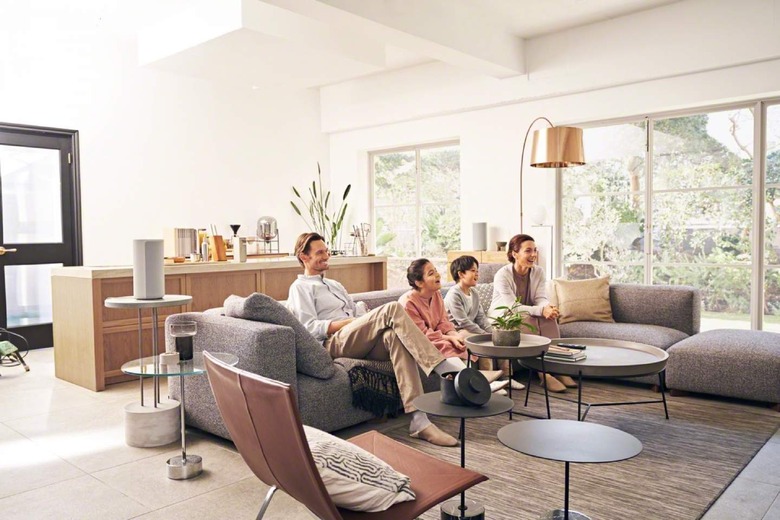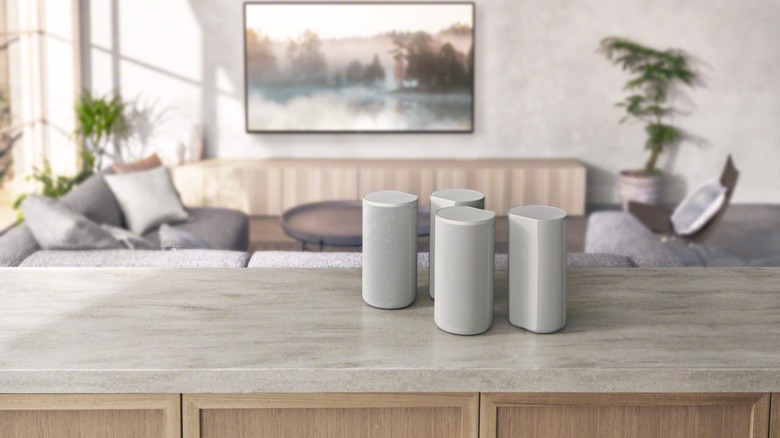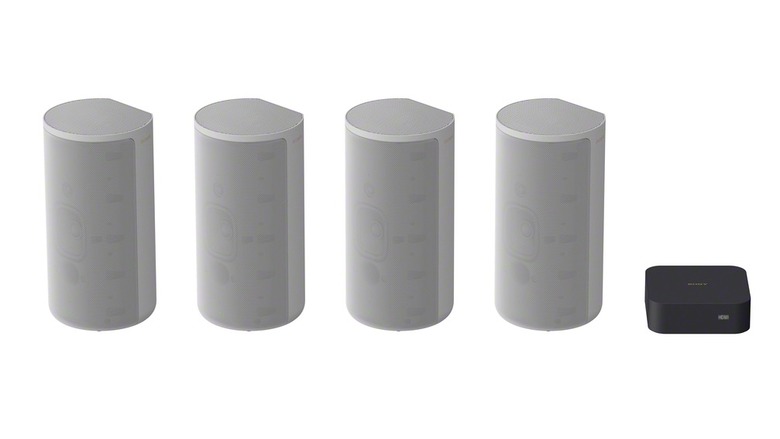Sony Is Taking A Geeky Gamble That Soundbars Aren't Enough Any More
It's fair to say that soundbars upended the home theater market. While their early iterations may have struggled to match the audio performance of a room full of individual speakers, advances in hardware and processing algorithms have made it possible to have effective surround sound from a single source in the room. Suddenly, you didn't need a big amp and seven or more different boxes – all trailing wires – to get that pseudo-theater effect.
In some ways, the Sony HT-A9 feels like a step back from that simplicity. Rather than a single soundbar, it's a set of four individual speakers, and an Apple TV-sized control box to manage them. If you want, you can pair it with an optional subwoofer.

Still, some of the big lessons learned from the ascendence of soundbars have been carried over. For a start, each of the speakers connects wirelessly: while the control box may have HDMI, power, and other ports on the back, the four individual speakers themselves only need a power connection. If you add the subwoofer, that links wirelessly too.
More important, though, is the flexibility. Traditional surround sound rigs are incredibly position-dependent. Get the speakers at the wrong location, or at the wrong height, and suddenly your sweet spot isn't on the couch like it should be.
Sony gets around that, though, with what it calls 360 Spatial Sound Mapping or 360 SSM. A Sony-developed, proprietary system, it not only automatically configures the A9 system but can take into account even dramatic differences in positioning of each unit.
For example, you might have the two front speakers at noticeably different heights. The rear speakers, meanwhile, could be placed on the floor, or one might be at ear level while the other is tucked off the side of the couch. The room itself could be open-plan, or have walls on one side but be open on the other, or have a peaked ceiling.
360 SSM works with two microphones in each speaker unit, plus a further microphone in the control box. The tuning process takes less than a minute, and you only need to do it once. After that point, the up-firing speaker driver, high-efficiency tweeter, and X-Balanced rectangular driver in each speaker is configured to take into account not only the audio they're playing, but the layout of the speakers themselves.
The result, Sony claims, is the equivalent of twelve "phantom" speakers, spread around the room. Since each unit is physically identical – beyond the fact it has its intended position printed on – there's no concern about outputs being misbalanced. You can tweak the settings according to the position of your TV to where you typically sit, and the maximum range between the speakers is about 30-33 feet.

Sony's target audience, the company says, is a tweener one of sorts: people who are aware of things like Dolby Atmos and DTS:X, and who want more from their home theater sound than a soundbar alone can provide, yet who don't want to go the whole hog with a room full of speakers. The A9, meanwhile, is as much a proof-of-concept for 360 Spatial Sound Mapping as it is a product in its own right.
While it uses four speakers, 360 SSM isn't really limited as a concept to that. The system could, theoretically, use more of those speaker units, and thus create even more "phantom" speakers in the room.
It's fair to say that the A9 is a fairly expensive test of the waters. When the system goes on sale around the start of Q4 this year, it'll be priced at $1,799.99. A wireless subwoofer will start at $399.99. Considering you can get a well-reviewed Dolby Atmos soundbar like the Sonos Arc for $799, that's a considerable premium.

All the same, the magic here is in the algorithm and its potential. Future 360 SSM-based systems could be cheaper, sure, but there's also the intriguing potential for baking the technology into other devices too. Liberated from the need to be positioned "perfectly" for surround sound use, it's not hard to imagine speakers included in other Sony devices that would be brought together wirelessly to make a home theater system when needed. Even, indeed, portable speakers that could be taken to the beach during the day, and then brought home to link up with a surround system at night.
Is that how Sony sees the future of its new audio tech panning out? For now, the company is reluctant to be drawn on how things might develop, though it's watching the response to the A9 closely as the system launches later in the year.
